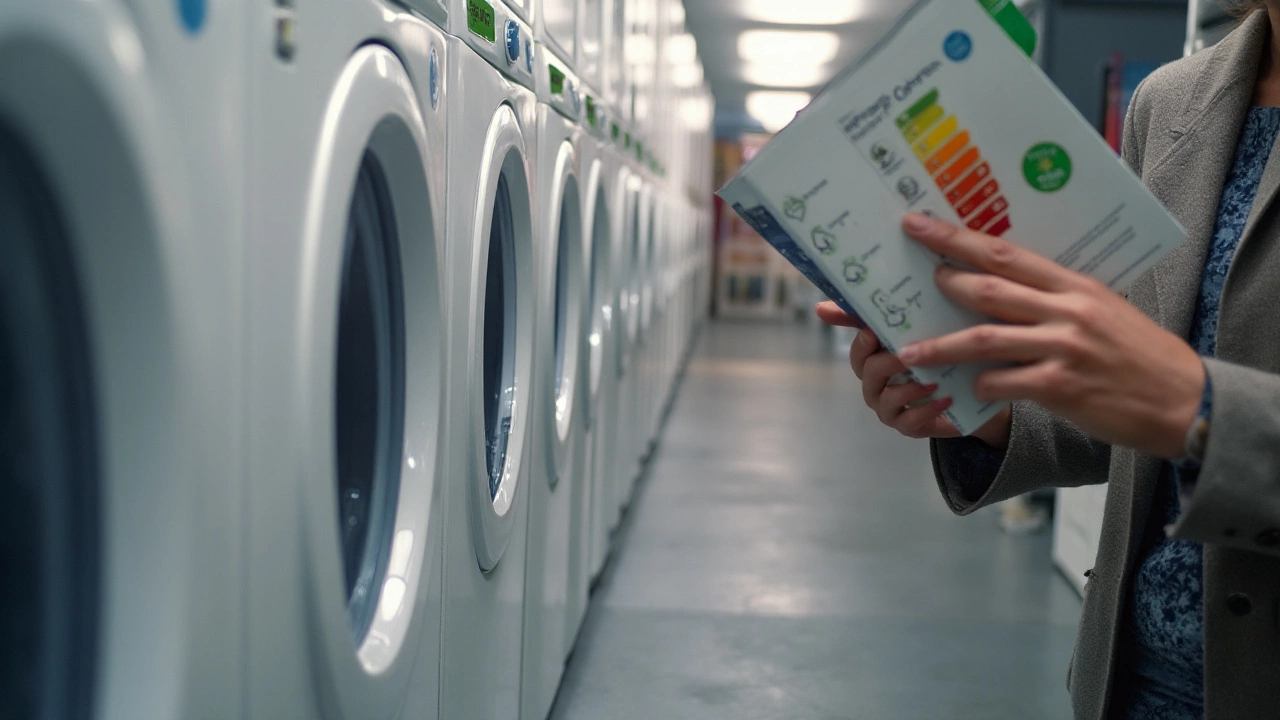
- 2 Nov 2024
- Gideon Thornton
- 0
In today's world, appliances play a critical role in our daily lives, influencing everything from the way we cook to how we stay cool during those sweltering summer months. But beneath their metallic exteriors, there's more at play than just convenience. The concept of 'appliance standards' is one that governs not only how these machines are built, but also how they perform.
Appliance standards act as a compass, steering manufacturers in the direction of improved energy efficiency and safety. These standards are meticulously crafted guidelines that dictate the energy consumption, performance, and safety criteria that appliances must meet. They're not just regulations; they're a testament to our collective effort to create a sustainable future.
For homeowners, understanding appliance standards is more than just trivia—it's a roadmap to smarter buying and maintaining choices. By grasping what these standards entail, you can ensure your household appliances are not only compliant but also optimized for long-term savings and efficiency.
- Introduction to Appliance Standards
- The Importance of Appliance Standards
- Types of Appliance Standards
- How Appliance Standards Affect Consumers
- Tips for Maintaining Compliant Appliances
Introduction to Appliance Standards
Appliance standards are like the silent heroes in our homes, quietly ensuring that our devices are efficient and safe. These standards have been evolving for decades, mirroring our society’s growing focus on sustainable living and energy conservation. The journey of appliance standards began with a recognition that as technology advanced, so too did the need for regulation to balance innovation with environmental responsibility.
Today, these standards are both national and international. They aim to set a bar for manufacturers to clear, covering a spectrum of appliances from refrigerators to washing machines. This is important not only for the market but for consumers as well, as it empowers them to make informed choices. Choosing an appliance that meets current standards means opting for energy savings and often subsidies, which can significantly impact utility bills. The Energy Star program by the Environmental Protection Agency is perhaps one of the most recognized benchmarks. It shows how collaborative government and industry efforts can result in highly efficient products.
The development of these guidelines is no small feat. It involves a plethora of stakeholders including governments, consumer organizations, and the appliance industry itself. A multi-tiered approach means that these groups work together to establish what performance criteria should be prioritized. A critical aspect of appliance standards is that they are continually revised and updated based on technological advancements and environmental needs. This dynamism ensures that the standards are relevant and effective. As a result, we see a steady improvement in appliance efficiencies, which has a ripple effect, reducing the carbon footprint of our everyday lives.
“Progress is impossible without change, and those who cannot change their minds cannot change anything.” — George Bernard Shaw
In addition to energy efficiency, appliance standards also keep a keen eye on safety. An appliance that is not up to the required standard can pose risks, from electrical faults to health hazards, meaning that high safety standards are absolutely imperative. These standards ensure that manufacturers incorporate multiple layers of safety checks into their products before they even reach the shelves. For consumers, this means peace of mind, knowing that the products they bring into their homes meet stringent safety checks.
Impact and Compliance
Compliance with these standards is not optional, but it can be complex. Manufacturers who wish to sell in certain markets must adhere to these guidelines. This is why appliances often come with various certifications, which might seem like just a sticker but hold immense value. For buyers, this is a critical signifier that the appliance aligns with legal and environmental expectations. The world is moving towards more stringent environmental regulations, and appliance standards are significantly contributing to this cause.
Undoubtedly, the detailed process of implementing appliance standards benefits everyone. On a macro scale, countries can reduce their overall energy consumption. On a micro scale, households can save money. According to data from the U.S. Department of Energy, homes adhering to modern appliance standards use about 25% less energy than older homes. This figure speaks volumes about the effectiveness of these guidelines.
| Year | Percentage of Energy Reduction |
|---|---|
| 2000 | 10% |
| 2010 | 17% |
| 2020 | 25% |
This achievement is not just a win for consumers, but also for the environment, pushing the envelope in the right direction towards sustainability. Navigating through the world of appliances without acknowledging their standards would be akin to driving without a map. Appliance standards set the course, guiding efforts towards efficiency, safety, and responsibility, allowing us to enjoy modern conveniences without compromising the future.
The Importance of Appliance Standards
The importance of appliance standards cannot be overstated. These standards create a foundation of reliability and trust, both for the consumer and the manufacturer. When it comes to household appliances, knowing they're held to specific criteria means consumers can expect consistent performance and safety. This is pivotal not only for day-to-day convenience but also in critical safety scenarios. Consider, for instance, the necessity for rigorous standards in appliances like gas stoves and electrical heaters, where the potential risks are higher without stringent guidelines.
From an environmental standpoint, appliance standards serve a dual purpose: they aim to reduce the carbon footprint and foster innovative energy solutions. In regions where energy efficiency is a priority, standards often dictate a product's eligibility for energy rebates. For example, the Energy Star rating is a glowing endorsement for products meeting high-efficiency guidelines. This accreditation helps cut down excessive power consumption, reflecting positively on both the planet and the utility bill at the end of the month. According to the U.S. Department of Energy, Energy Star appliances, on average, use 10 to 50% less energy compared to standard appliances, leading to significant annual savings.
Home appliances that adhere to set standards provide a peace of mind warranty to the owner. It’s akin to buying a safety net that goes beyond conventional guarantees. For example, during the manufacturing process, these appliances undergo rigorous testing to ensure they meet or exceed the requirements laid down by authorities like the Consumer Product Safety Commission (CPSC) or Underwriters Laboratories (UL). This level of scrutiny helps minimize the risk of failures and recalls, which could not only be inconvenient but also costly from an economic and sometimes a personal safety standpoint.
"Quality is never an accident; it is always the result of intelligent effort." This quote by John Ruskin reflects the essence of appliance standards. Without these efforts, consumer trust could erode over time, leading to a fragmented market where reliability is hit and miss.
For consumers, understanding these benchmarks ensures better purchasing decisions. It's like having a guidebook that deciphers specifications and certifications on products. This knowledge empowers shoppers to identify which models will provide long-term value both economically and environmentally. Over time, stringent standards push manufacturers toward research and development of better technologies. This continuous advancement leads to smarter, longer-lasting, and more environmentally friendly products.
Additionally, having uniform appliance standards helps level the playing field globally. Internationally recognized benchmarks can remove barriers to cross-border trade, allowing consumers access to a wider range of innovative products. It's a win-win scenario where competition fosters innovation, driving prices down while maintaining quality. The next time you shop for any home appliances, remember the role these standards play in guaranteeing both safety and efficiency.

Types of Appliance Standards
When you start exploring the world of appliance standards, it quickly becomes clear that they aren't one-size-fits-all. Instead, there's a diverse spectrum tailored to different needs and goals. Primarily, these standards fall into categories like energy efficiency, safety, and performance. Each holds its own significance, knit together by a singular aim: enhancing our everyday experiences while minimizing environmental impact.
Energy efficiency standards are possibly the most talked about. They aim to reduce the power that appliances consume, resulting in lower electricity bills and a decrease in greenhouse gas emissions. For instance, the Energy Star program, a joint initiative of the U.S. Environmental Protection Agency and Department of Energy, sets specific benchmarks. Appliances that meet these standards often carry the Energy Star label, instantly recognizable and respected worldwide. These criteria not only encourage manufacturers to innovate but also help consumers make informed choices.
The realm of safety standards focuses on ensuring the secure operation of appliances, helping prevent accidents such as electrical fires or electrical shocks. Organizations like Underwriters Laboratories (UL) and the International Electrotechnical Commission (IEC) are stalwarts in this field, setting high bars for operational safety. These standards encompass everything from ensuring insulation quality to scrutinizing the durability of appliance components.
Next up are performance standards, which guarantee that appliances don't just work—they work well. These are crafted with a view to ensuring that an appliance performs its designated task effectively and efficiently over a certain duration. Such standards might dictate, for instance, that a refrigerator should be able to maintain a constant, optimal temperature to ensure food safety.
"Appliance performance standards not only ensure consumer satisfaction but strive to cultivate trust in technological advancements," mentioned Jane Frazer, an expert in home technology solutions.
In addition to these major categories, there are also appliance standards devoted to environmental impact, noise control, and design. Each plays a vital role in shaping the appliances that enter our homes. For example, environmental standards might focus on the end-of-life processes of appliances, ensuring they are recyclable or biodegradable, hence contributing less to landfill. Meanwhile, noise standards provide a quieter home environment by mandating specific decibel limits for certain appliances, crucial for maintaining peace in tightly-knit urban settings.
Understanding these distinct types of appliance standards empowers consumers to make smart choices. It's a matter of comparing what a new model on the market promises versus what it's required to deliver. It also pressure manufacturers to evolve continuously, pushing the boundaries of technology and sustainability. Whether you're choosing a new washing machine or evaluating the efficiency of your AC, knowing about these standards equips you with the tools to make sound decisions for your household and our planet.
How Appliance Standards Affect Consumers
When you walk into a store to buy a new refrigerator or washing machine, you might not immediately think about the invisible hand guiding these modern marvels—appliance standards. These standards, often set by government agencies and industry bodies, are crucial for ensuring that the appliances we use every day are safe, durable, and efficient. But how do these standards directly affect you, the consumer? Let's dive into the impacts, both visible and hidden, that these regulations have on our lives.
Firstly, appliance standards significantly influence the energy consumption of products. Standards ensure that appliances meet specific energy efficiency requirements, which help to reduce the overall energy demand of households. For instance, the U.S. Department of Energy (DOE) establishes efficiency regulations that result in an estimated $63 billion in consumer savings annually in energy costs. This not only means lower utility bills but also contributes to environmental conservation by reducing greenhouse gas emissions. These benefits are passed on to consumers in the form of more sustainable living options.
Another vital aspect of appliance standards is safety. These standards include measures for preventing fires, electrical shocks, and other hazards that could arise from using household appliances. Safety standards protect consumers from potential dangers by ensuring devices are adequately tested before reaching the market. This has an enormous impact on consumer trust and brand reputation. A household stove or oven with a proper safety certification assures the user of reduced risk during usage, providing peace of mind and promoting a safe environment at home.
Moreover, appliance standards affect your purchasing decisions. When manufacturers comply with these standards, they include labels on products indicating performance metrics and energy use. These labels make it easier for consumers to compare different products and make informed purchasing decisions. Take the Energy Star label, for example, highly regarded and recognized by consumers for high-efficiency products. As a result, manufacturers are encouraged to innovate and improve their products to meet these standards, which in turn fosters competition and keeps prices competitive, giving consumers more options and better value for their money.
Additionally, compliance with appliance standards can sometimes result in higher initial costs for products, as manufacturers invest in technologies and processes to meet these standards. However, the long-term savings in energy costs and extended appliance lifespans balance these upfront costs. For consumers, this translates into better investments and enhanced returns. According to the International Energy Agency, every dollar spent on improving appliance efficiency returns about $2 in savings over the product’s lifetime. Such statistics underscore the financial benefits of adhering to appliance standards.
To sum it up, the influence of appliance standards on consumers cannot be overstated. They play a crucial role in shaping energy costs, safety, purchasing decisions, and long-term financial planning. By understanding how these standards work, consumers can better navigate the market, choosing appliances that not only meet their needs but do so in a way that's safe, economical, and environmentally friendly.

Tips for Maintaining Compliant Appliances
Keeping your home appliances in good shape is a mix of routine maintenance, smart usage, and informed decision-making. Regular checks and some simple habits can ensure that your appliances meet the appliance standards and provide efficient service for years to come. It all starts with reading the manufacturer's manual. These documents are designed to offer guidance on how to get the best performance from your appliance, including specific maintenance routines that could keep them compliant with standards. This simple step is often overlooked, but it can light the path to longer-lasting devices.
Energy efficiency is a huge part of why appliance standards exist, and regular cleaning is essential in maintaining this efficiency. Dust and grime can heavily impact the energy usage of devices. For instance, refrigerator coils collect dust over time, which makes the motor work harder and consumes more energy. Cleaning such components is typically straightforward and can drastically improve the appliance's life. Similarly, air conditioner filters should be cleaned regularly to ensure adequate airflow and cooling efficiency, thus meeting energy use guidelines.
Another factor to consider is timely repairs. Ignoring small issues can lead to bigger problems, which not only affect the performance but can also lead to significant non-compliance with set standards. A simple rattling sound in a washing machine could be a loose part today but might result in a more significant issue tomorrow if unattended. Regular professional inspections are a recommended approach for detecting and dealing with such issues early. Experts often detect problems that can easily be missed by the untrained eye. Insights from reliable experts, such as Consumer Reports, suggest that regular checks can lower the risk of failure by up to 30%.
"Routine maintenance is key to ensuring that appliances are both effective and safe," mentions an expert from Appliance Repair Bluebook.
Appliance maintenance isn't complete without addressing energy load management. Many home appliances like dryer and dishwashers are energy-intensive, and using them during peak hours can strain the electrical systems, potentially leading to non-compliance with regulatory demands. By scheduling appliance usage during off-peak times, you not only save on energy bills but also contribute to a balanced energy ecosystem—a crucial aspect of energy compliance. This simple practice ensures that your appliances are not hogging unnecessary resources, thereby keeping things efficient.
Lastly, consider the age of your appliances. Older models may struggle to meet new energy efficiency standards. If an appliance requires frequent repairs or shows signs of age-related inefficiency, it might be time to invest in newer, more efficient models. Newer appliances often come with enhanced features that make your life easier while adhering to all the latest appliance standards. Many reputable brands now focus on sustainability, demonstrating how compliance can align with being environmentally friendly.




